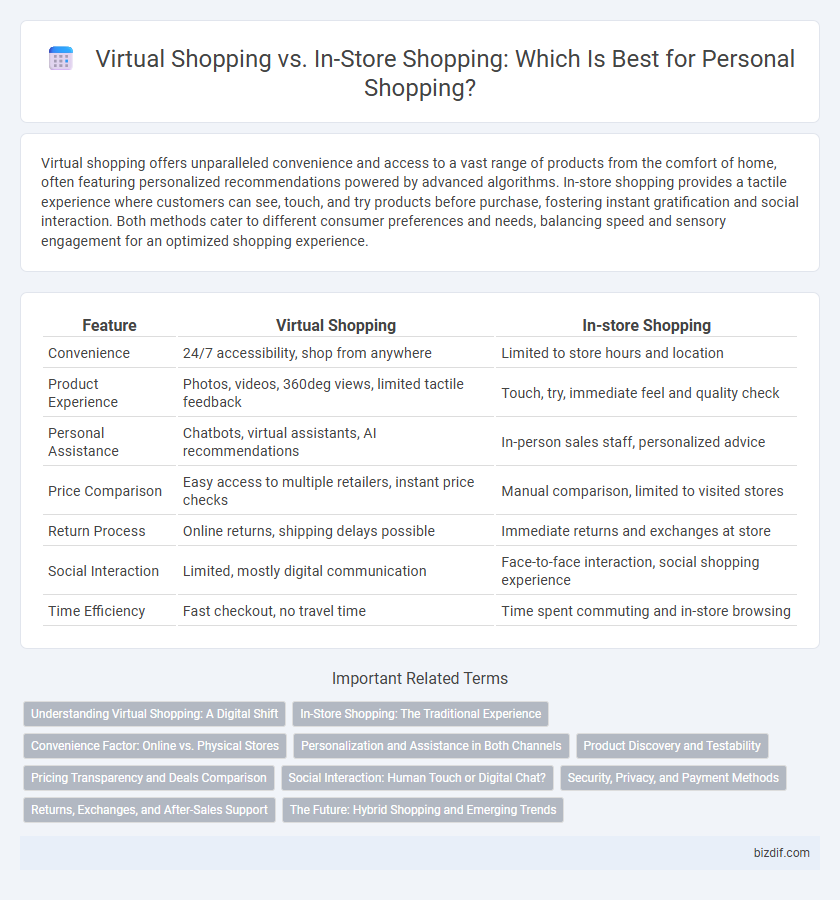Virtual shopping offers unparalleled convenience and access to a vast range of products from the comfort of home, often featuring personalized recommendations powered by advanced algorithms. In-store shopping provides a tactile experience where customers can see, touch, and try products before purchase, fostering instant gratification and social interaction. Both methods cater to different consumer preferences and needs, balancing speed and sensory engagement for an optimized shopping experience.
Table of Comparison
| Feature | Virtual Shopping | In-store Shopping |
|---|---|---|
| Convenience | 24/7 accessibility, shop from anywhere | Limited to store hours and location |
| Product Experience | Photos, videos, 360deg views, limited tactile feedback | Touch, try, immediate feel and quality check |
| Personal Assistance | Chatbots, virtual assistants, AI recommendations | In-person sales staff, personalized advice |
| Price Comparison | Easy access to multiple retailers, instant price checks | Manual comparison, limited to visited stores |
| Return Process | Online returns, shipping delays possible | Immediate returns and exchanges at store |
| Social Interaction | Limited, mostly digital communication | Face-to-face interaction, social shopping experience |
| Time Efficiency | Fast checkout, no travel time | Time spent commuting and in-store browsing |
Understanding Virtual Shopping: A Digital Shift
Virtual shopping revolutionizes consumer behavior by enabling access to vast product selections anytime through digital platforms, eliminating geographical and time constraints common in traditional in-store shopping. Advanced technologies like augmented reality and AI-driven recommendations enhance user experience by providing personalized, interactive browsing and fitting options. This digital shift significantly influences purchasing decisions by offering convenience, detailed product information, and contactless transactions, reshaping retail dynamics in the personal shopping sector.
In-Store Shopping: The Traditional Experience
In-store shopping offers a tactile and immersive experience where customers can physically interact with products, ensuring accurate assessment of quality and fit. The ability to receive immediate assistance from knowledgeable sales staff enhances decision-making and personalized recommendations. This traditional shopping method also supports spontaneous discovery and social engagement, elements difficult to replicate in virtual environments.
Convenience Factor: Online vs. Physical Stores
Virtual shopping offers unmatched convenience with 24/7 access, eliminating travel time and allowing easy price comparisons from home. In-store shopping provides immediate product inspection and personalized assistance, catering to tactile preferences and instant gratification. Consumers prioritize convenience factors differently based on urgency, product type, and personal preferences in the shopping experience.
Personalization and Assistance in Both Channels
Virtual shopping offers tailored product recommendations through AI algorithms that analyze user preferences and browsing history, enhancing personalization beyond traditional in-store experiences. In-store shopping provides immediate, face-to-face assistance from trained staff who can offer personalized styling advice and tactile product evaluations. Both channels aim to optimize customer satisfaction by delivering customized support, whether through digital interfaces or direct human interaction.
Product Discovery and Testability
Virtual shopping offers extensive product discovery through advanced filtering, personalized recommendations, and augmented reality tools that simulate product use. In-store shopping provides immediate testability, allowing consumers to physically examine, touch, and try products before purchase, enhancing confidence and satisfaction. Combining both approaches can optimize the shopping experience by leveraging virtual convenience with tangible product interaction.
Pricing Transparency and Deals Comparison
Virtual shopping offers enhanced pricing transparency through real-time comparison tools and access to a wide range of discounts from multiple retailers simultaneously. In-store shopping often lacks immediate price comparison, making it harder to identify the best deals without additional research. Shoppers benefit from virtual platforms by easily finding the lowest prices and exclusive online promotions unavailable in physical stores.
Social Interaction: Human Touch or Digital Chat?
In personal shopping, social interaction varies significantly between virtual shopping and in-store experiences. In-store shopping offers direct human touch through face-to-face engagement, allowing for personalized assistance and spontaneous social connections that enhance customer satisfaction. Virtual shopping relies on digital chat and AI-driven support, which provide convenience and instant responses but may lack the emotional nuance and empathy present in human interactions.
Security, Privacy, and Payment Methods
Virtual shopping platforms implement advanced encryption protocols and multi-factor authentication to enhance transaction security and protect user privacy. In-store shopping offers direct payment options like cash, cards, and contactless methods, reducing the risk of digital fraud but requiring vigilance against physical theft. Both environments utilize secure payment gateways, yet virtual shopping demands robust cybersecurity measures to safeguard sensitive customer data.
Returns, Exchanges, and After-Sales Support
Virtual shopping offers streamlined returns and exchanges through prepaid shipping labels and easy online refund processes, enhancing convenience compared to in-store shopping. In-store shopping provides immediate after-sales support, allowing customers to exchange products or address issues on the spot without shipping delays. Both channels vary in return policies and customer service responsiveness, impacting overall satisfaction in personal shopping experiences.
The Future: Hybrid Shopping and Emerging Trends
Hybrid shopping combines the convenience of virtual shopping with the tactile experience of in-store shopping, revolutionizing how consumers engage with brands. Emerging trends include augmented reality for virtual try-ons, AI-powered personalized recommendations, and seamless integration of online and offline inventory. Retailers investing in hybrid models are expected to enhance customer satisfaction and boost sales by catering to evolving consumer preferences.
Virtual shopping vs In-store shopping Infographic

 bizdif.com
bizdif.com